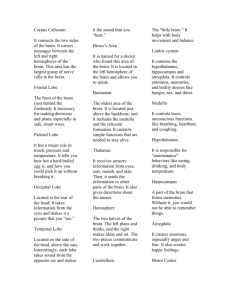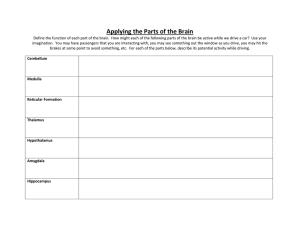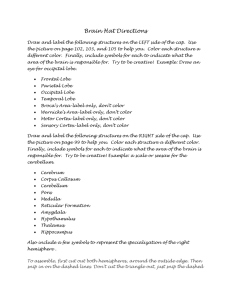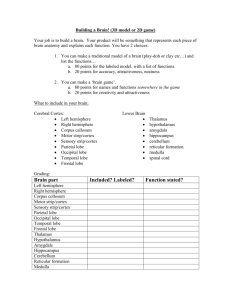Parts of the brain webquest 2011
advertisement
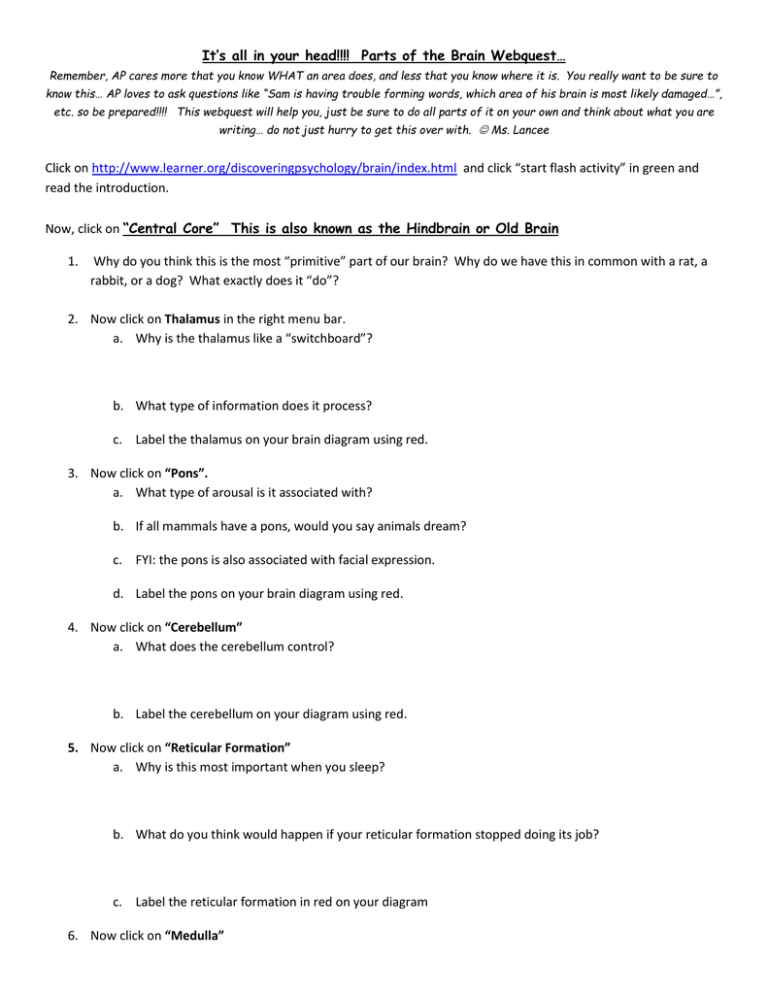
It’s all in your head!!!! Parts of the Brain Webquest… Remember, AP cares more that you know WHAT an area does, and less that you know where it is. You really want to be sure to know this… AP loves to ask questions like “Sam is having trouble forming words, which area of his brain is most likely damaged…”, etc. so be prepared!!!! This webquest will help you, just be sure to do all parts of it on your own and think about what you are writing… do not just hurry to get this over with. Ms. Lancee Click on http://www.learner.org/discoveringpsychology/brain/index.html and click “start flash activity” in green and read the introduction. Now, click on “Central Core” This is also known as the Hindbrain or Old Brain 1. Why do you think this is the most “primitive” part of our brain? Why do we have this in common with a rat, a rabbit, or a dog? What exactly does it “do”? 2. Now click on Thalamus in the right menu bar. a. Why is the thalamus like a “switchboard”? b. What type of information does it process? c. Label the thalamus on your brain diagram using red. 3. Now click on “Pons”. a. What type of arousal is it associated with? b. If all mammals have a pons, would you say animals dream? c. FYI: the pons is also associated with facial expression. d. Label the pons on your brain diagram using red. 4. Now click on “Cerebellum” a. What does the cerebellum control? b. Label the cerebellum on your diagram using red. 5. Now click on “Reticular Formation” a. Why is this most important when you sleep? b. What do you think would happen if your reticular formation stopped doing its job? c. Label the reticular formation in red on your diagram 6. Now click on “Medulla” a. One could argue that the medulla is the most important part of your brain, why? b. Label the medulla in red on your diagram. Now click on The Limbic System 1. The limbic system is called the brains “emotional” center. What else does it do (explain all functions)? 2. Click on “Hippocampus” a. What three important roles does the hippocampus play? b. Click on “Research in Action” in the bottom right. How does it relate to Alzheimer’s disease? c. Label the hippocampus on your diagram in green. 3. Now click on “Amygdala” a. What roles does the amygdala play? b. How might a person act if the amygdala was severed or abnormal? c. Label the amygdala in green on your diagram. 4. Now click on “hypothalamus” a. Why is your hypothalamus so important? b. Label your hypothalamus in green on your diagram. Click on Cerebral Cortex 1. Why does the cerebral cortex “set us apart from the animals?” 2. Click on Frontal Lobe a. How does our frontal lobe assist us in everyday life? b. Label your frontal lobe in blue on your diagram. 3. Click on Occipital Lobe a. The main function of the occipital lobe is _____________________. b. How does it work with the parietal and temporal lobes? c. Label your occipital lobe in blue. 4. Click on Parietal Lobe a. Describe the challenges you would face if your parietal lobe was compromised. b. Label the parietal lobe in blue. 5. Click on Temporal Lobe a. What is your temporal lobe allowing you to do right now? b. Label the temporal lobe in blue. 6. Click on Research in Action a. When your teacher asks you to read allowed in class, explain the steps involved from seeing the word on the page, to interpreting it, to speaking it. Now that you “know it all” fill in the blank with what area is most likely affected. Scenario John used to be very balanced emotionally, but lately he is very aggressive and prone to fits of rage. This part of Sheila’s brain suffered trauma and within seconds she was dead. Susan suffered head trauma and had blurred vision. She also reported seeing stars in her field of vision. Scott was sleeping, but as the sun came through the window he woke up. Connor was constantly running into objects and having trouble perceiving where they were spatially. June is having trouble processing memories. Ashley is becoming nauseous because her equilibrium is off. She can hardly walk a straight line. Jordan feels extremely hungry. Tessa knows she is touching a cold ice cube, but she doesn’t feel a thing. Area of brain Here are the brains you will label. You have two views, as some brain areas will work better with placement on the cross-section and others will work better on the whole brain. Be sure to color code each name/label in the appropriate color so that you know which “brain system” it falls under. Hindbrain= red Limbic System =green Cerebral cortex=blue

